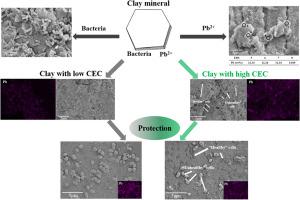Ecotoxicology and Environmental Safety ( IF 6.2 ) Pub Date : 2020-11-26 , DOI: 10.1016/j.ecoenv.2020.111704 Mu Su , Feiyu Han , Mengxiao Wang , Jingxuan Ma , Xuewei Wang , Zhijun Wang , Shuijin Hu , Zhen Li

|
Clay minerals can adsorb both microorganisms and heavy metals. In this study, typical soil bacterium, Enterobacter sp. was applied to investigate the potential protection of the bacterial cells from Pb2+ stress by clay minerals. The sorption by two representative types of montmorillonite (Mt) were contrasted, i.e., Mts/Mtw with strong/weak CEC. There was no significant difference between the two clay minerals regarding their adsorption of Pb2+ cations in water (i.e., ~55 mg L-1). However, the sorption of bacterial cells on the two clay minerals showed evident contrasts, which resulted in the different capacity of Pb sorption. Mts with high CEC preferentially adsorbed abundant bacterial cells (rather than Pb2+) on its surface. The residual Pb2+ concentration in solution actually raised by 7.5% after the addition of Enterobacter sp. In addition, both the Pb-contaminated cells and “healthy” cells (with low Pb contamination) could be adsorbed onto Mt surface, whereas the latter dominated the adsorbents on Mts. This was due to that the Mts with high CEC could provide more exchangeable cations, building more cation bridging ligands between the microbial cells (whatever the types of cells) and clay surface. Furthermore, the adsorbed “healthy” bacterial cells might escape from clay surface via “self-liberating” mechanism, i.e., increasing electrostatic repulsion between the bacteria and clay during microbial decomposition of the medium. This study hence elucidated the protection of microorganisms from Pb2+ stress by Mt.
中文翻译:

肠杆菌属的黏土辅助保护。来自铅(II)应力
粘土矿物可以吸收微生物和重金属。在这项研究中,典型的土壤细菌肠杆菌属。为了研究黏土矿物对细菌细胞免受Pb 2+胁迫的潜在保护作用。对比了两种代表性类型的蒙脱石(Mt)的吸附,即Mt s / Mt w与强/弱CEC。两种粘土矿物之间在水中吸附Pb 2+阳离子(即〜55 mg L -1)之间没有显着差异。然而,细菌细胞在两种黏土矿物上的吸附表现出明显的反差,这导致铅的吸附能力不同。山小号具有高CEC的细胞优先在其表面吸附大量细菌细胞(而不是Pb 2+)。加入肠杆菌后,溶液中残留的Pb 2+浓度实际上提高了7.5%。此外,受Pb污染的细胞和“健康”细胞(低Pb污染)均可被吸附到Mt表面,而后者则占Mt s上的吸附剂最多。这是由于该山小号具有高CEC的化合物可以提供更多可交换的阳离子,从而在微生物细胞(无论细胞类型如何)与粘土表面之间建立更多的阳离子桥连配体。此外,被吸附的“健康”细菌细胞可能会通过“自我释放”机制从黏土表面逸出,即在培养基的微生物分解过程中增加细菌与黏土之间的静电排斥力。因此,这项研究阐明了保护微生物免受Mt对Pb 2+胁迫的影响。











































 京公网安备 11010802027423号
京公网安备 11010802027423号